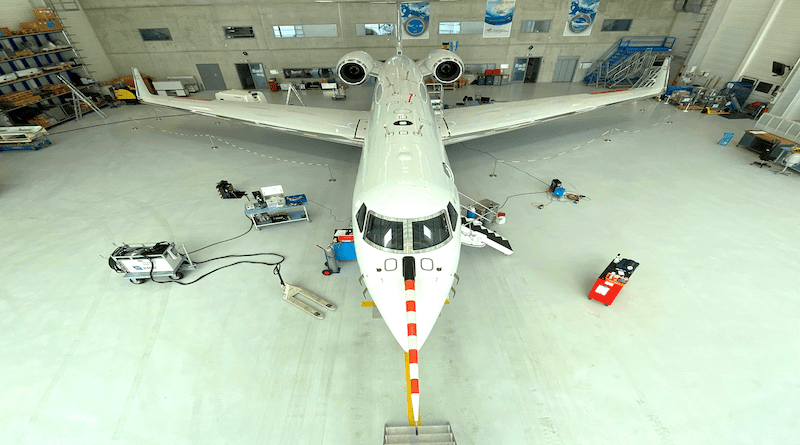HALO Research Aircraft To Analyze Transport Of Greenhouses Gases And Aerosols Over Pacific
The extreme precipitation that occurs during the Asiatic monsoon season repeatedly causes catastrophic devastation in Southeast Asia. The same weather systems which cause these extreme events also affect the altitude region of 12 to 20 kilometers.
Strong convection transports partly heavily polluted air masses from the ground-level atmosphere in Southeast Asia into this altitude region, the so-called upper troposphere/lower stratosphere, and from the northern Pacific subsequently to Europe. This transport will be investigated over the next two months by a team of atmospheric researchers during the PHILEAS (Probing High Latitude Export of Air from the Asian Summer Monsoon) mission. Forschungszentrum Jülich and Johannes Gutenberg University Mainz (JGU) are coordinating the project. Airborne measurement flights using the high altitude HALO aircraft will be taking off from Oberpfaffenhofen in Bavaria starting on Sunday and from Anchorage in Alaska in about two weeks.
One key objective of the two-month campaign is to obtain insight into the transport and mixing processes that occur in the upper troposphere and lower stratosphere influencing the global climate and weather. A second focus will be on the severe wildfires in Canada.
“The information we collect will allow us to look at the long-range transport of contaminants from the monsoon regions. Furthermore, we will concentrate on the impact of the disastrous forest fires in Canada and their consequences for the stratosphere. The heat of the fires can result in powerful convection currents that bring aerosols and pollutants to elevations of 12 kilometers or more. The innovative payload configuration used for PHILEAS provides us with the opportunity to investigate the effects and development of the smoke plumes on the corresponding composition and their impact on the environment,” explained Professor Peter Hoor, head of the Airborne Measurements group at the Institute of Atmospheric Physics at Mainz University. The PHILEAS data are also a central element for transport and aerosol studies within CRC TRR-301 “TPChange”, which is headed by the Professor Peter Hoor at Mainz University.
Especially during summer, both local fires and also the long-range transport from Asia contribute to the pollution in the lower stratosphere. During the summer, the Asian monsoon distributes aerosols and greenhouse gases throughout the entire Northern Hemisphere. Its extensive convective transport carries contaminated near-surface air layers in Southeast Asia up to a height of some 16 kilometers. Here the polluted air accumulates in the so-called monsoon anticyclone, a gigantic high-pressure zone in the upper troposphere over East Asia. The monsoon anticyclone can, at times, stretch all the way from the Arabian Peninsula to the Pacific coast of Asia. During summer and early autumn, air masses containing increased levels of greenhouse gases and aerosols frequently split off from this high-pressure zone. These then move northeast over the Pacific and are subsequently mixed into the lower stratosphere. In addition to the pollutants, water vapor is also conveyed into the lower stratosphere, which is climate-relevant in this high-altitude region.
“In the initial phase of PHILEAS, we will be assessing the westward transport of polluted air masses originating from the monsoon anticyclone flying from Oberpfaffenhofen towards the Arabian Peninsula. The eastward transport of the polluted air masses over the Pacific to high altitudes and their incorporation in the lower stratosphere will be examined in a second campaign phase by flights from Anchorage,” said Professor Martin Riese, Director of the Stratosphere section at the Institute of Energy and Climate Research (IEK) at Forschungszentrum Jülich.
The aircraft carries a novel combination of highly sophisticated instruments. These combine state-of-the-art remote sensing technologies with high-precision local in-situ measurements. To be able to adapt the flights ideally to the respective meteorological conditions, a large forecast group will be present in Oberpfaffenhofen and Anchorage. Mainz University provides the meteorological forecast data, which are generated by the European Center of Medium-Range Weather Forecast (ECMWF), to the science team. Chemical information will be generated by the Chemical Lagrangian Model of the Stratosphere (CLaMs) system developed at Jülich.
The key pollution markers such as carbon monoxide, methane, and ethane, which can be used to identify different sources of pollution, are measured by the group headed by Professor Peter Hoor from JGU. Aerosol composition will be measured with the novel ERICA instrument jointly developed by the Max Planck Institute for Chemistry and Mainz University. A core instrument on board HALO is the infrared spectrometer GLORIA (Gimballed Limb Observer for Radiance Imaging of the Atmosphere), which allows 3D tomographic mapping of temperatures, cloud parameters, and the levels of numerous trace gases in the atmosphere.
The PHILEAS mission will conclude in early October 2023 with a measurement phase at its base in Oberpfaffenhofen. Comparison of the results of this with the early phase will enable the researchers to ascertain the effects that the monsoon system has on the lower stratosphere over Europe.

